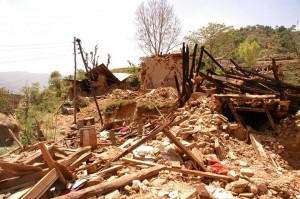
Nepal Earthquake One Year Later
By AdministratorIt has been one year since Nepal was hit by a 7.8 magnitude earthquake. It was the worse earthquake the earthquake-prone region experienced since 1934, which killed thousands and destroyed 20% of the Katmandu’s buildings. Nepal is particularly vulnerable because of low construction standards and political instability. Last April, villages across the country were flattened and landslides cut many villages off from rescuers and emergency supplies. The situation was made worse when a week and a half later a major a 7.3 magnitude aftershock hit. Many response workers were injured or killed by the second quake hindering the rescue and response efforts. In total over 8,500 people were killed and almost 18,000 were injured.
 One year later, there are still several people missing. The Nepalese government says 500,000 people lost their homes, but aid organizations estimate the number to be in the millions. The International Federation of Red Cross and Red Crescent Societies estimates that 800,000 buildings were damaged, but rebuilding has been slow hampered by bureaucracy and protests. Many remain in makeshift shelters that often did not provide adequate shelter from the harsh winter.
One year later, there are still several people missing. The Nepalese government says 500,000 people lost their homes, but aid organizations estimate the number to be in the millions. The International Federation of Red Cross and Red Crescent Societies estimates that 800,000 buildings were damaged, but rebuilding has been slow hampered by bureaucracy and protests. Many remain in makeshift shelters that often did not provide adequate shelter from the harsh winter.
 Our Humanist Disaster Recovery beneficiaries have been working hard to aid their communities and country recover. Single women were hit particularly hard as an already marginalized group. Women displaced from their homes in the aftermath of the earthquake are more susceptible to abuse, disease, and violence. With their shelter, childcare, health, and training programs, The Women’s Foundation Nepal (WFN) is continuing to help the women in their community recover. Gurkha Welfare Trust’s (GWT) Gurkha community was directly impacted by the earthquakes. Thirteen Gurkha veterans or widows were killed and over 2,000 of their houses were destroyed or damaged. Over the last year, GWT has built 70 houses and have 500 further houses under construction. They have also repaired 32 schools and are working on four more. GWT is on track to have 46 water projects repaired and 81 new water projects completed by June. WFN and GWT have been contributing to the recovery in difficult circumstances. Your support during our HDR drive helped make this work possible. As always, we thank you for your generous giving. This is humanism at work.
Our Humanist Disaster Recovery beneficiaries have been working hard to aid their communities and country recover. Single women were hit particularly hard as an already marginalized group. Women displaced from their homes in the aftermath of the earthquake are more susceptible to abuse, disease, and violence. With their shelter, childcare, health, and training programs, The Women’s Foundation Nepal (WFN) is continuing to help the women in their community recover. Gurkha Welfare Trust’s (GWT) Gurkha community was directly impacted by the earthquakes. Thirteen Gurkha veterans or widows were killed and over 2,000 of their houses were destroyed or damaged. Over the last year, GWT has built 70 houses and have 500 further houses under construction. They have also repaired 32 schools and are working on four more. GWT is on track to have 46 water projects repaired and 81 new water projects completed by June. WFN and GWT have been contributing to the recovery in difficult circumstances. Your support during our HDR drive helped make this work possible. As always, we thank you for your generous giving. This is humanism at work.
For more information about the Nepal one year later, see these articles:
https://time.com/4305225/nepal-earthquake-anniversary-disaster/
https://www.bbc.com/news/world-asia-36104268
https://www.huffingtonpost.com/tracy-fehr/one-year-later-earthquake_b_9774010.html
Follow Humanist Disaster Recovery Network on Facebook for updates on future HDR Drives and information on volunteering with HDR Teams.
Photos courtesy of Women's Foundation Nepal
